|
| |
| |
| |
Portfolio Abel Buell
By Donald Weeks
‘A jack of all trades & genius extraordinary’ is the way one contemporary termed Abel Buell, the first...
To the question, who are my three favourite Americans? without any hesitation my reply would be: Abel Buell, Homer Lea and Robert Benchley - in that order. Pressed to name a fourth, he would be Lafcadio Hearn.
A hunchback of small stature, Homer Lea was in China during the Boxer Uprising and secured the office of General in the Chinese Army.
On his only trip to Japan, he was made aware of the nature of her military treachery. Before he died in 1912, his book The Valor of Ignorance, detailed Japan's future plans for the seizure and occupation of the Philippines - in the exact manner she accomplished this invasion in December 1941. As a cub reporter for a Cincinnati, Ohio, newspaper, Lafcadio Hearn wrote ‘The Tan-Yard Murder’ - the most horrific article in newspaper history of anything pertaining to the gruesome. Known as The Raven, Hearn later settled in Japan - conscious only of the land's peace and beauty. Robert Benchley never saw Japan, but he was familiar with Europe. One thing which he wrote achieved the pinnacle of singular expression over tomes of literature. In only six words he summed up a true nature of Venice in a cable he sent back home: ‘streets filled with water. please advise.’ Among his humorous writings can be found the essay ‘Paul Revere's Ride’ - which perhaps is truer than any account of the episode in any history book. Sub-titled ‘How a Modest Go-Getter Did His Best for the Juna Acid Bath Corporation,’ this essay unfolds on the nights of 16-18 April 1775 and tells of the Go-Getter's perseverance in finally landing ‘an order of three dozen tins of Vulcan No. 2 and a dozen jars of Acme Silver Polish, as Mr. Revere is a silversmith also on the side’.
Being about half a dozen years older, Mr. Paul Revere knew Abel Buell both socially and as a co-worker. At the time of their association, each was but a straw in the winds of turmoil - a turmoil leading to Revolution. These men were but two who existed between the times when the British-American colonies were small and insecure until they were united and independent, facing the internal and external problems of a new, populous nation. Transplanted Europeans suddenly became Americans without realizing the fact. Once in the New World, immediate practical demands on the one hand and abundance of land on the other transformed their initial habits and experiences into a combined citizenry of a new life and future. When they discovered how little the British government in the 1760s understood what they had become and what could be expected of them, they gradually began to take responsibility for their own society. The township and counties of the American colonies provided a general, united patriotism: the Revolution to ensue from their joint efforts produced no isolated hero. This was a Revolution of Men - to result in a government for all people - a
| |
| |
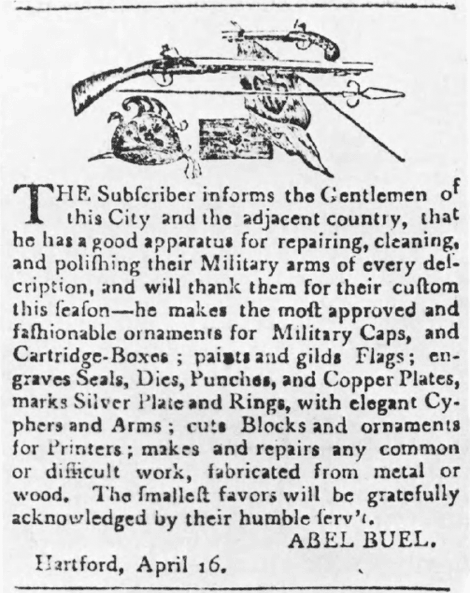
Abel Buell's advertisement in the American Mercury, Hartford, for 16 April 1801. This is both a sample of his type and the block above it, designed and cut by him.
| |
| |

A diploma form designed and engraved by Buell for Yale College, about 1774.
| |
| |
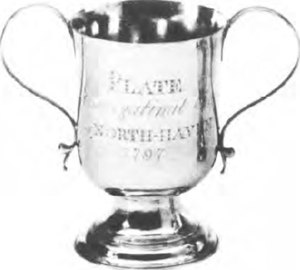
One of four identical communion cups made by Buell in 1797 for the North Haven Congregational Church.

Two salt spoons, designed and manufactured by Buell, each carrying his mark: ‘A.B.’
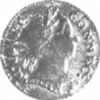
These Connecticut pennies were designed by Buell in 1785, after which he cut the dies
for their manufacture.
| |
[pagina 52-53]
[p. 52-53] | |
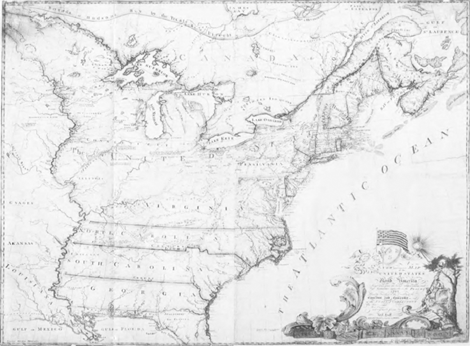
Abel Buell's ‘NEW and correct MAP of the UNITED STATES of NORTH AMERICA,’ the largest map designed and printed by one person in the Colonies of the new United States by 1783.
Copyright © the British Library
| |
| |
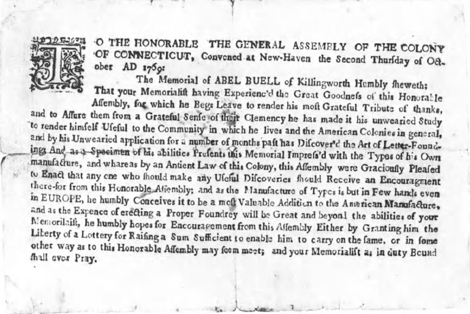
The Memorial to the Connecticut Assembly of October 1769, which was printed in the second font of type of Buell's handicraft. This Memorial was printed in red.
| |
| |
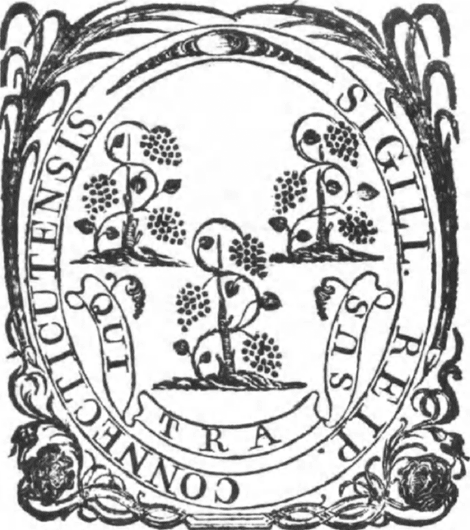
The arms of Connecticut as engraved by Buell.
| |
| |
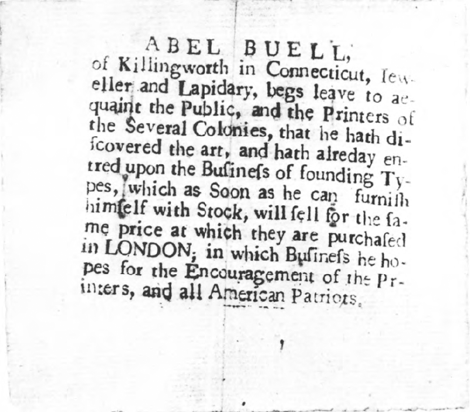
‘The first proof struck by American types,’ 1769, from the first type designed and cast in the Colonies, done so by Abel Buell. There is only one copy of this specimen surviving today.
| |
| |
democracy rather than the sovereignties whose heads ruled vast throngs of people without ever permitting one person's word to be heard. With the coming of peace in 1783, one of the founders of the new United States of America, Thomas Jefferson, dreamed of a vast land, all united in the conformity of the new government's humanitarian purpose. The original colonies along the East Coast could extend westward. The Louisiana Purchase of 1803 ably added to the middle interior. To obtain knowledge of the continent's true size - expanding to the West Coast - Jefferson sent out Merriwether Lewis and William Clark in the spring of 1804 to map the area beyond the last citadel then known. By 1806, this expedition proved that an overland route to the Pacific was feasible and provided scientific data about this hitherto unexplored land - the vastness of which would one day form into forty-eight connected states. Jefferson lived, only just, to see the fiftieth anniversary of American Independence on 4 July 1826. Abel Buell had lived out his long life four years before.
With this emergence of a new nation as a backdrop and in the comparatively sparcely populated panorama of the New World, Abel Buell was born on 1 February 1742, in Killingworth in the Colony of Connecticut, the son of two colonists. The event for his birth was hardly newsworthy outside of the immediate circle of family and acquaintances. For more than two centuries, this event has hardly been the origin of ever-widening concentric ripples which accord to some names, by this day, some import of renown. Even today, the name of Abel Buell eludes many biographical dictionaries. The sign under which he was born was not one that illuminated posterity.
As was the order of the day, the boy, at a certain age, was apprenticed to a goldsmith/silversmith, who later moved to New Haven, the site of most chapters in Buell's life. (Although practitioners of the art were known as goldsmiths in the early days of the colonies, they dealt mostly in silver, a metal easier to acquire and work with.) In 1762, his apprenticeship now completed, Buell established himself as goldsmith/silversmith in Killingworth, no older than twenty-one, and marrying Mary Chittenden as his first wife.
The story of any early American is that of a person from a small town. Nowhere in the colonies had any cosmopolitan style of life yet been adapted. The Abel Buell who was to live out his various-talented life was a product of this era and community, which size separated it from the much more populated regions across the wide Atlantic. In such a setting, in such a society, he lived and dreamed. And with each new dream, with each new pulse urging him on to a life in a certain direction, he gambled, if only unconsciously. At times he gained: at times he lost: but, winner or loser, he persisted in his efforts to promote to his utmost the materialization of the objects of his dreams. The first note struck in the ‘progress’ of Abel Buell's life came in 1745 - when he was condemned to prison, condemned to be cropped of one ear and condemned to be branded on the forehand with the letter C. The young silversmith of Killingworth had proceeded to increase his (failing?) wealth by forging two bank notes. The denomination of each note - two shillings six pence - had been forged to the more comfortable figures of thirty shillings. According to the law of his day, Buell's property was ordered to be sold to reimburse the holders of the notes of his handicraft. In this, Buell was certainly neither unique nor the originator of bank-note forgery. The crudity of notes in the British-American colonies was such that forgery had been a common practice for a number of years. There had been no over-all systematic design of notes and local forms of government permitted numerous printers to strike-off the required currency. A law of 1724 provided the forger with the loss of his right ear, branding on the forehead,
forfeiture of his entire estate, and life imprisonment. The C for counterfeiter was duly applied to Abel Buell's forehead - causing him ever afterward to wear a broad- | |
| |
brimmed hat over a kerchief tied around his head. His youth saved him the mutilation of his right ear. Only the barest tip of it was cropped. However, his property went to the auctioneer's block and he was sent to the New London prison. Never a person to remain complacent within an immediate, especially enforced, environment, Buell almost instantly sent a petition to the Connecticut Assembly for an appeal. The first petition, sent late in 1764, received no notice and was followed by a second in 1765, again asking reconsideration in his case. Each was rejected by the Assembly. In October 1767, Buell made a new demand. This plea broadened itself beyond his own being. In this new demand, he added that, while in prison, he had worked diligently at perfecting a machine for cutting and polishing crystals and precious stones. This was his first achievement and Abel Buell was the first man in the colonies to have invented such a machine. This evidence of his labour so impressed the Assembly that his liberty was restored and he was once again pronounced a free man. The now freed Abel Buell returned to being a silversmith, practicing as ‘Ieweller and Lapidary’. Although New Haven was to be the centre of his experiences, it was at this time that he first displayed an inclination toward an ambulatory life. The first advertisement for his skills after completing his stay in prison was seen in Boston - ‘the hub of the world’.
Although the first claim to his inventive genius can be given to the work of a ‘Lapidary’, the most important event in his life of innovations was to follow before the first blasts of the American Revolution were to be heard. Wearing the concealed C upon his forehead for twenty-three years, Abel Buell left one deciding mark upon American history - a mark much to his credit.
‘The first proof struck by American types’ was taken in 1769. ‘Our American genius, Abel Buell, is now manufacturing Tipes for printing... equal to any European ones.’ Abel Buell was the first man in America to design and cast type.
There was a parallelism between the origins of colonial crafts and the early stages of the same crafts in medieval Europe - each following its own series of evolutionary steps toward perfection. The goldsmith or silversmith was also an engraver - the process of engraving being accidentally discovered by a goldsmith in Florence. In many incidences, the smith's apprentice was first used as an engraver of a dish, a sword hilt, a piece of ware or a belt plate. Abel Buell graduated from the ranks of silversmith and lapidarianism to the art of type making. Before him, Gutenberg had found an improved method of polishing precious stones before he perfected the cutting and casting of type. Fust had been a goldsmith before his adventures into the new field of casting type and printing. (Because of the sorcerous-like appearance of the newly printed sheets - all exactly alike - the citizens of Paris, who declared that his red ink was in actuality blood, seriously adjudged Fust - then in partnership with Peter Schoeffer - to be in league with the devil. Thus did Fust lend his name to the legend of ‘The Devil and Doctor Faustus’.)
One thing remains truly unique about Abel Buell's first efforts in casting type. He was a British-American colonist but an American patriot. The first recognized flare of American displeasure against British rule was the Boston Tea Party, when a number of Americans disguised as Indians threw 342 chests of British tea in the harbour on the night of 16 December 1773. However, local repraisals had already been made for a long time, each displaying an individual's dismay or that of a small group of men. The statue of George iii naturally had been erected in town squares throughout the colonies as a reminder of their sovereign. These statues, made of lead, were toppled over at various times, indicating a greater ambition of the colonists: to topple over the entire British government. In 1769, one such statue was overthrown and one of Buell's friends gave him the head of George iii, made of lead. This Abel Buell melted down and used in the first type to
| |
| |
be cast in America. Thus was Great Britain and America - so unceremoniously and so uneventually - joined together in this momentous endeavour.
‘It is very extraordinary that such a specimen (of type) should be made without instruction, from the mere force of genius,’ wrote a contemporary; ‘and the man that was capable of this must be capable of making his letters still more perfect. If Mr. Buell would accomplish this, all who have seen the specimen agree that the letters would be as handsome as those that come from Home (England).’ The colonies at this time had to depend on England for all material connected with printing. From the Bay Psalm Book of 1640 until the days of the Revolution - which included the printing days of Benjamin Franklin - all type came from across the Atlantic. At the outbreak of hostilities, such supplies were cut off - the type being used continually until each character was literally worn out. Type designing and casting, then, would have been a boom in America. On 4 September 1769, the Massachusetts Gazette published the fact of Buell's invention. This was followed by a claim which Buell presented in a Memorial to the Connecticut Assembly, asking for subsidy to engage further in this matter. A loan was not advanced until after August 1770, when ‘types were made at N Haven’. However, Buell eventually failed to prosecute the business of type founding at this time. This was entirely due to the lack of full financial aid - from without and from the business itself within. A mortgage on his property meant little - just to enable a trickle of needed type at the time. His type did flourish, though, but at a later date. It can be seen in the Connecticut Journal in 1781, in Bickerstaff's Almanack for 1782, in the New England Almanack for 1783, and in Timothy Allen's Salvation of All Men, Put Out of All Dispute.
However, there was enough of the initial type to be used in a number of wartime publications printed in Connecticut beginning in the early 1770s. Abel Buell was Connecticut's first engraver. The work done for this claim for a large engraving: the ‘Chart of Saybrook Barr,’ at the head of the Connecticut River. In 1770, the Assembly moved that access to the Connecticut River towns should be made easier from the Sound. To this end, the Connecticut River Lottery was set up in 1773 and a year later the task of producing an engraved maritime map of the area was delegated to Abel Buell. The money granted for this project was:
| ‘To 2 Large Copper Plates |
£ |
6.5.0 |
| To Engraving 2 Large Copper Plates |
|
30.0.0 |
| |
£ |
36.5.0’ |
This sum was allotted Buell to undertake the work, which was no mere piece of artistic or imaginative fancy. It was an actual map, properly sounded and surveyed for the ‘Directions to find ye channel’. That this engraving - being a meter long and only slightly this measurement in depth - was a true map was proved by the many ships which used it in this area - each navigating ‘Saybrook Barr’ with Buell handiwork. The last known date of the use of this map was at least 1788 - but it could have been referred to at much later, but unrecorded, times.
Two other surviving examples of Abel Buell's artistic engraving are a diploma for Yale College, perhaps executed in 1774, and a writing sheet, The Sequel of Arts and Sciences, engraved about the same time. This latter work to revolve into a new episode in his life. By 1774, his first wife had died and he now married Aletta or Letty Devoe, at a time when a new calamity caused the self-exiling of himself to Florida. The Sequel of Arts and Scienes was ‘Printed for & Sold by the propietors A.B. and J.R. in New-Haven’ - ‘J.R.’ being ‘James Rivington of the City & Province of New York merchant’ - a British loyalist printer in the larger city. On 11 February 1775 - but ten days after Buell's thirty-third birthday - Rivington asked the authorities that the goods or estate of Buell be attached to the amount of 1,000 pounds, ‘York money,’ to cover in- | |
| |
debtedness amounting to 500 pounds in the same currency. The plea was made and a writ executed. How Buell had become indebted to the New York printer and publisher is still an unanswered question. It certainly could not have happened through the capacity of his silversmith or jewelry work or through any efforts of his connected with type founding. ‘The First Connecticut Engraver’ may have carried on this portion of his art to a greater extent than is known today and, in this way, created transactions which placed him in Rivington's indebtedness. At any rate, Buell was far from the scene when, in April 1775, a band of Connecticut ‘Sons of Liberty’ invaded New York, attacked and virtually ruined the British loyalist publisher's place of business, hanging Rivington in effigy. As an American
patriot and a private enemy of the New York publisher, Buell must have approved of the broadside of satirical verses, The Last Words, Dying Speech, and Confession of J---s R----g--n, P---t-r... Who Was Executed at New Brunswick... on the Thirteenth Day of April 1775. By December 1774, Buell had fled any jurisdiction over him by joining the migrators southward bound. His next home was Pensacola in Florida, not yet a part of the American states. But, back in Connecticut, Aletta Buell lashed out her fury against Rivington through the medium of newspapers.
At this conjunction of events, a person from Holland entered into Buell's life: Bernard Romans, engineer and cartographer. Exactly when the two met, is not known, but, during Buell's exile from New Haven, Romans encouraged Aletta to maintain her husband's business by continually producing and selling the products of his engraving work, such as the Yale College diploma. Romans, as a cartographer, published maps of areas in the New World - maps which bore his name but some of which were skillfully engraved by Abel Buell. Before his flight to Florida, his experience in engraving was employed by Romans - in a joint work produced in the New York business house of Rivington. Romans was engaged in issuing a map of Florida. The data - surveying, etc. - had all been accomplished and it now only needed to be translated into engravings. For this period, in the accounts books of Paul Revere, charges were entered against Romans for plates of ‘a map of East Florida,’ ‘part of a map of Florida’ and a third plate - charged for work done in May, July and October 1774. Two other men worked on the same project: an unknown, unnamed craftsman and Abel Buell. Upon completion of the Saybrook Bar chart, Rivington introduced Buell to Romans. The Hollander's book, A Concise Natural History of East and West Florida, was issued from the Rivington house by the first of April 1775 - containing three harbour charts - ‘Pensacola Bar,’ ‘Mobile Bar’ and ‘Entrances of Tampa Bay’ - which match in delicacy of style and lettering Buell's chart of Saybrook Bar. In this book, one more illustration was to appear. The reason why it did not was given by Romans: ‘The map of the
country of savage nations (of the Seminole Indians, who to this day maintain their own land in Florida - a portion of land never annexed to the United States), intended to be put, facing page 72, was engraved by a Gentleman who resides in the country 60 or 70 miles from New York, to whom the plate was sent; but when it was sent back, it miscarried, through the carelessness of the wagoner...’ - ‘60 or 70 miles from New York’ being the distance to New Haven and the ‘Gentleman’ being Abel Buell. When the Florida exile was back in New Haven in 1779, although never a bookseller, he was advertising for sale Romans' Annals of the Troubles in the Netherlands. So, there was a joint working relationship - at least on one occasion - between Abel Buell, Paul Revere, Rivington and Romans. Abel Buell was not only Connecticut's first engraver, but the arms of the state were engraved by him in 1784. The charges for this were entered in the Assembly's books as:
| ‘To Abel Buell's Bill for engraving the State Arms |
[£] |
2.0.0. |
| To cash paid for Copper for the same |
|
0.4.0.’ |
| |
| |
As far as it is known, Buell did no printing for the state. However, an advertisement of his in the Hartford American Mercury for 16 April 1801 lists a number of accomplishments he could do, including: ‘cuts blocks and ornaments for printers; makes and repairs any common or difficult work, fabricated from metal or wood.’ Over this advertisement is a cut designed by him. In this light, Abel Buell was the first American to cast a design in metal for printing purposes. In 1784, he had already cast the arms of Connecticut in metal, at least for embossing.
Abel Buell's greatest visual achievement was his ‘map of the United States of America, laid down from the latest observations and best authorities, agreeable to the peace of 1783’. This was ‘ready for subscribers’ by 31 March 1784. Measuring more than a meter both in width and depth, this had been the largest piece of engraving done in America up to this time. It also was the first map ‘ever compiled, engraved, and finished’ by one man in the New World and it was the first map of the new United States issued after the peace of 1783. The colours on the map - for outlines of the states - were hand-applied. One of the interesting features of the map is the elaborate cartouche in its lower right-hand corner - a display of thoughtfullness in design and fludity and vigour in execution - depicting an extremely fine example of Buell's pictorial skill. The American flag, with its thirteen stars and stripes, waves above two cherubs. One lustily acclaims the emblem with a trumpet, while the other displays the three grape-laden vines of the arms of Connecticut. There is a radiant sun with a human face, above a sturdy tree and a rock throne, upon which is seated Liberty, holding in her right hand a staff surmounted by the Liberty cap and in her left hand a globe on which appears the word ‘America’. Beneath Liberty's feet are engraved on the open ground:
‘independence / july iv / mdcclxxvi’. Flowing horns of plenty and foliage complete the base of the design. But the most remarkable, the most significant thing about the entire map is its imprint: ‘Newhaven Published according to Act of Assembly.’ This highly significant imprint bears special interest to both historian and bibliographer. In 1783, the Connecticut Assembly passed a general law for the protection of literary property. This was the earliest American copyright law. Abel Buell's phrase, ‘Published according to Act of Assembly,’ was the first claim to copyright to be printed in or upon an issue of a press in the new United States of America.
Among his various inventions, Abel Buell numbered a coin-making machine. The Assembly, in 1785, authorized ‘a mint for coining and manufacturing coppers [pennies]’. They were to be in weight and design similar to the British half-penny. Connecticut - the state which branded and imprisoned him for forgery in 1764 - now, in 1785, commissioned Abel Buell to be its first minter of coppers. His skill as engraver and mechanic became the core of the Company for Coining Coppers. In its first two years - half of its life, from 1785 to 1789 - the company minted 3,908 pounds, 6 shillings and 8 pence of copper coins. Buell's creation for the coin was:
Device or Obverse: A bust in coat of mail, head laureated, and facing to the right.
Legend: Auctori Connec.
Reverse: The Goddess of Liberty seated on the globe, facing to the left, the Liberty pole, surmounted by the cap, in the left hand, and the olive branch in the right.
Legend: Inde: et Lib.
Date: 1785.
After his return to Connecticut in 1778, Buell's activities - including those already mentioned above - became more varied and larger in scale - at least, for some time. He had been discharged from being a bankrupt in 1778, on May 19th of which year Governor Trumbull commissioned as a privateer a sloop, Porcupine - the owners of the ship being Abel Buell & Company of New Haven. Before the close of
| |
| |
the war between the American colonies and Great Britain, it is now known that Buell was engaged at least once again in the romantic business of privateering. Carrying two guns and thirty-six men, the sloop Tiger was commissioned on 1 June 1782 - and among the men associated in her building was Abel Buell. One profitable prize fell to her before the peace of 1783 put an end to her forays against the enemy's commerce.
The local newspaper advertised that Buell's venues would be held under his management at the Sign of the Coffee Pot, near the State House, New Haven. His business branched out into various commercial, mechanical and artistic fields for some fifteen years - his name being coupled with different other names from time to time, in one venture or another. After his loss of Aletta, he wedded a third woman, a Rebecca Parkman Townsend, in a marriage lasting longer than the others. As for his commercial activities, Buell was offering for sale just about everything from sealing wax to ships. He was also an auctioneer and a proprietor of a line of packet boats plying their way between New Haven and New London. When the pennies were still being minted for Connecticut, Buell sailed to England in 1789. He was a mint master and was seeking a dependable copper supply. But, once in England, his attention was drawn to a new invention - but not of his own making: the cotton mill. To obtain full knowledge of machinery and processes, he let himself be employed in a mill. By 1793, he was back home - ‘Abel Buell late of New Haven now residing at the cotton manufactury near New York, N.Y.’ Not for the only time - in order to finance some new enterprise - he mortgaged his property to acquire the needed money to begin whatever new business his mind entertained. In a contemporary diary of 1795, one person wrote: ‘I rode out... to view Mr. Buell's Cotton Manufacty 2 M[iles]. off. It cost 2000 dollars [and] will succeed...’ But the prophesised success never occurred. Once again his failure was due to that same theme which hounded so many of his other ventures:
lack of ready money. No doubt he had the ability to foresee a future in whatever business he entered but he may have been a poor orator when it came to asking for money for these enterprises. In whatever way he dealt with such matters, he now was soon parted from the world of general commerce and had to turn back to rely on the practice of his own handicrafts for a means of income. In 1796, the ‘ingenious mechanic’ advertised: ‘Mariners’ and surveyors' compasses and other instruments cleaned and rectified, engraving, seal and die sinking, seal presses, enameled hair working mourning rings and lockets, fashionable gold rings, earrings and beads, silver, silver-plated, gilt and polished steel buttons, button and other casting moulds, plating mills, printers blocks, coach and sign painting, gilding and varnishing, pattern and models of any sort of cast work; mills and working models for grinding paints as used in Europe; working models of canal locks, drawings on parchment, paper, silk, etc., by Abel Buell, College Street, New Haven, where there is a decent furnished front chamber to be let by the week.’ Later in the same year, he had ‘on exhibition the wonderful negro who is turning white’ - as attested to by the president of Yale College, Timothy Dwight, who had already written about America:
‘Here Empire's last, and brightest throne
And Peace and Right, and Freedom, greet
Two years after the above advertisement appeared, Buell's latest invention was a device intended for planting onions and corn - the first of its kind.
The cross-section diagnosis of a person divides the dreams from the realities. Expounding his genius, Abel Buell so many times failed to create a long-term commercial success. In many incidences, this was simply due to an eagerness over a new project meeting with the lack of fully essential funds to promote such a scheme at the initial moment. Nevertheless, he never
| |
| |
ceased being a true artist and inventor. The subtlety of his silver fashioning can be seen in the four communion cups he executed for the North Haven Congregational Church in 1797, two years before he moved to Hartford and six years before he lost his third wife, only to marry once again.
The fact that Abel Buell, due to the area in which he existed, as so many of the New World's population, was considered a smalltown person compared to today's seemingly total cosmopolitanism can be enlarged in defining his talents. These also had to do with the era in which he lived. He was born during the year Benjamin Franklin, of New England stock, invented his stove - ‘a very considerate advantage in a large family’. Franklin's lightning rod was invented in 1752. Eli Whitney's cotton-gin was invented in 1793. Robert Fulton's steamboat was invented in 1809 and Cyrus Hall McCormick's reaper, Samuel Morse's electric telegraph, Charles Goodyear's vulcanizing process for rubber, and Elias Howe's sewing-machine were all invented within the generation following Buell's death. Many of such inventions were obviously the priority the New Englander placed on education, giving that region - the colonies north of New York, which included Connecticut - an extraordinary advantage over the other colonies. The term ‘Yankee’ became a byword for ingenuity. The Yankee was known as a tinkier of genius or mechanical wizard. The self-sufficient New England community made demands on that Yankee ingenuity. Few farms were without their small workshops. Nails, clothes, utensils, tools, implements and even clocks were manufactured on the farm during the long winters and the New England farm came to be known as ‘the best school of mechanics’. When Francis Lowell introduced the power loom to America in 1814, he found plenty of skilled workers with ‘the training of many generations of farmer-mechanics in the workshops of New England.’
Not only was New England a land where improvisation was necessary to overcome a harsh climate and a niggardly natural environment, the rule of Puritanism always encouraged scientific inquiry. The Puritan ethic insisted on industry and denounced idleness as a sin. Although his life followed this pattern, Buell was not always a ‘true believer’ in religion. He had become an infidel through intimate association with Tom Paine - the same Tom Paine who wrote Common Sense, the battle cry supporting the American Revolution. A resident of Stockbridge in 1813, Buell had a change of heart and became a great reader of the Bible. He exclaimed one day to a visitor: ‘They have been altering the Bible! This is not the same book which Tom Paine and I used to ridicule! They have altered it; they have altered the Bible. This is beautiful! oh, how beautiful! All beautiful! beautiful, beautiful.’ So, at more than seventy years of age, he joined the church - the Congregational Church of Stockbridge.
In its obituary column of Saturday, 23 March 1822, the New Haven Columbian Register included: ‘At the Alms House in this town, on the 10th, Mr. Abel Buell, aged 81, an ingenious mechanic...’
‘Mr. Abel Buell’ today exists in a No Man's Land between shadow and substance. All of the above story has been pieced together from scraps of reference material containing, in some incidences, hardly more than his mere name. These ‘glimpses,’ these ‘salient points’ of an individual are all that remain of one human being. No one person or group of people has ever undertaken the study into this one man's life and inner character. Gertrude Stein bequeathed trunks filled with slips of paper to an American university - trunks containing even her laundry slips. How can such pieces of paper - printed or written upon - depict the delineations of a soul? In one of her novels, Marie Corelli wrote: ‘The soul! What is it? A fiction or a fact?... Of what is it composed, that it should be judged as so much more precious than the body?’ It is thus that here is presented Buell's body as shadow, his soul as
| |
| |
substance - the substance of an artist as expressed by George Grosz. ‘Do you, dear friend,’ Grosz one day addressed Titus Tautz, the co-chairman of the Dadaists in Germany, ‘happen to know what the artist is looking for?’ ‘Not remotely,’ said the gifted Tautz. ‘Very good, I agree,’ said Grosz, ‘and the important thing is he must never find it. He will become, then, only a successful man.’
Although his name appears in a document here, in a letter there, who was Abel Buell? What manner of man was he? What was he? What colour were his eyes? How tall was he? How did he dress? Although, through records, his name may be seen coupled with others in this event or that business, who were his friends and comrades? He was the first person to do this, the first person to attempt that; but what of his spirit? He was a loyal patriot for the American cause; but what of his inner self? This brief record of him is no more than a matter of words - words which speak not of an openness of mind, an openness of heart - if it were not for a closing word. Here was a man whose life spanned the biblical years, who successively married four wives, who fathered children. To know so much, can it be that nothing is known? But, then, what about his social life? He lived here, there; but what part did he put into the society of each community? What was the closest thing to his heart? In his ending days, did he re-live his travels, his adventures or misadventures, his inventions, the money or profits won or lost by them? Or did he ponder upon one thing which he gave to his fellow men - for the pure pleasure of enjoyment and with no thought of reward - save the self-satisfaction of adding to the welfare of others?
In 1742, he was born - born to live for others. His handicraft enabled others to benefit from his talents - coming from his very soul. All the bits found with his name embossed upon in whatever fashion mean so little - compared to a single vital piece of information. That he was attached to his fellow men - to their rejoicing in the fulness of the enjoyment of this life - is attested to by one more fact pertaining to Abel Buell.
Abel Buell was the first person on American soil to make a violin.
|
|